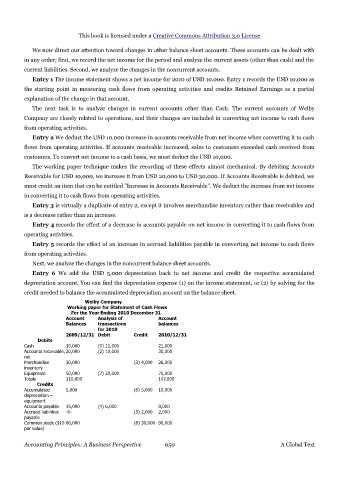Page 649 - Accounting Principles (A Business Perspective)
P. 649
This book is licensed under a Creative Commons Attribution 3.0 License
We now direct our attention toward changes in other balance sheet accounts. These accounts can be dealt with
in any order; first, we record the net income for the period and analyze the current assets (other than cash) and the
current liabilities. Second, we analyze the changes in the noncurrent accounts.
Entry 1 The income statement shows a net income for 2010 of USD 10,000. Entry 1 records the USD 10,000 as
the starting point in measuring cash flows from operating activities and credits Retained Earnings as a partial
explanation of the change in that account.
The next task is to analyze changes in current accounts other than Cash. The current accounts of Welby
Company are closely related to operations, and their changes are included in converting net income to cash flows
from operating activities.
Entry 2 We deduct the USD 10,000 increase in accounts receivable from net income when converting it to cash
flows from operating activities. If accounts receivable increased, sales to customers exceeded cash received from
customers. To convert net income to a cash basis, we must deduct the USD 10,000.
The working paper technique makes the recording of these effects almost mechanical. By debiting Accounts
Receivable for USD 10,000, we increase it from USD 20,000 to USD 30,000. If Accounts Receivable is debited, we
must credit an item that can be entitled "Increase in Accounts Receivable". We deduct the increase from net income
in converting it to cash flows from operating activities.
Entry 3 is virtually a duplicate of entry 2, except it involves merchandise inventory rather than receivables and
is a decrease rather than an increase.
Entry 4 records the effect of a decrease in accounts payable on net income in converting it to cash flows from
operating activities.
Entry 5 records the effect of an increase in accrued liabilities payable in converting net income to cash flows
from operating activities.
Next, we analyze the changes in the noncurrent balance sheet accounts.
Entry 6 We add the USD 5,000 depreciation back to net income and credit the respective accumulated
depreciation account. You can find the depreciation expense (1) on the income statement, or (2) by solving for the
credit needed to balance the accumulated depreciation account on the balance sheet.
Welby Company
Working paper for Statement of Cash Flows
For the Year Ending 2010 December 31
Account Analysis of Account
Balances transactions balances
for 2010
2009/12/31 Debit Credit 2010/12/31
Debits
Cash 10,000 (0) 11,000 21,000
Accounts receivable, 20,000 (2) 10,000 30,000
net
Merchandise 30,000 (3) 4,000 26,000
inventory
Equipment 50,000 (7) 20,000 70,000
Totals 110,000 147,000
Credits
Accumulated 5,000 (6) 5,000 10,000
depreciation –
equipment
Accounts payable 15,000 (4) 6,000 9,000
Accrued liabilities -0- (5) 2,000 2,000
payable
Common stock ($10 60,000 (8) 30,000 90,000
par value)
Accounting Principles: A Business Perspective 650 A Global Text

